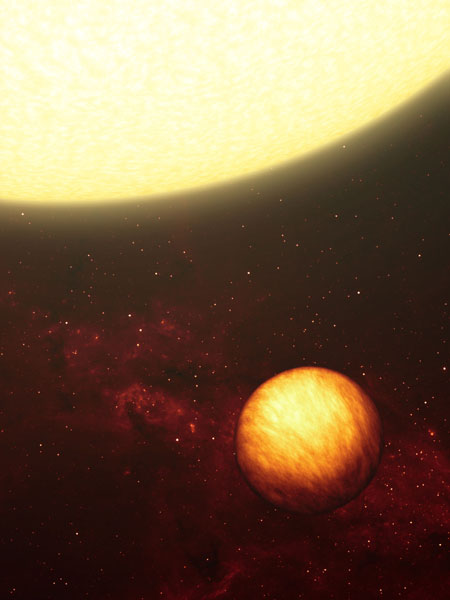Giant Planets Pack Supersonic Winds

SEATTLE -Heated winds on at least three planetsoutside our solar system blow sostrongly that the worlds are kept at a constant toasty temperature, even the night sides that never face their parent stars.
The planetsare called "hotJupiters" because they are large and gaseous like Jupiter, but orbit much closer totheir stars. All three orbit within about five million miles (eight millionkilometers) of their stars, much closer than Mercury is to our Sun. Scientiststhink winds on the planets blow at supersonic speeds, as strong as 9,000 miles(14,500 kilometers) per hour, churning their home worlds' atmospheres and keepingtemperatures on their dark sides from plunging.
For morethan a decade scientists have wondered whether, like Jupiter, the temperatureon hot Jupiters are constant, or if there are sharp temperature differencesbetween their day and night sides.
Thefindings
LastOctober, a team of astronomers led by Brad Hansen of the University ofCalifornia, Los Angeles discovered evidence of the latter on a nearby hotJupiter called Upsilon Andromeda b [image].
Hansen'steam found that one half of Upsilon Andromeda b was as hot as molten lava,while the other half was chilled possibly below freezing. The researchersspeculated that the sunlit side of the fireand ice planet was perhaps tidallylocked to its stellar parent, like the Moonis with Earth, so that only one sideof the planet faced the star. Another possibility was that Upsilon Andromeda bwas somehow shedding heat from its star rapidly into space, before its windscould circulate it to the night side.
The newfinding, presented here at the 209th meeting of the AmericanAstronomical Society, suggests the alternative heating scenario predicted byscientists can occur as well.
Breaking space news, the latest updates on rocket launches, skywatching events and more!
In late 2005,the researchers used NASA'sSpitzer Space Telescope to gather infrared readings from each of theplanets at eight different positions in their orbits. They measured the thermalbrightness of the planets when their day sides faced Earth, when their night sides faced Earthand at various phases in between. They found no variation in the infraredbrightness, suggesting no widely varying temperature differences between theplanets' day and night sides.
Instead, theplanets all appeared to have a uniform temperature of about 1,700 degreesFahrenheit (925 degrees Celsius). The planets are all slightly cooler than theywould be if they did not have winds to circulate heat.
"Thecooling occurs via thermal infrared radiation, which is why the planet has amore uniform brightness," said study team member Eric Agol of theUniversity of Washington. "The heat absorbed on the dayside is carried byfast winds, partly releasing the heat on the day side and partly on the nightside."
The three planetsare 51 Pegasi, HD179949b and HD209458b. They are located about 50, 100 and 147light-years away from Earth, respectively. Because they each orbit so close totheir stars, the researchers think the planets are probably tidally locked totheir stellar parents.
51 Pegasi wasthe first planet discovered orbiting another star in 1995. Since then, thenumber of known extrasolar planets has swollen to more than 200 and themajority of them are hot Jupiters. Astronomers expect to eventually find largenumbers of smaller planets, when technology allows.
More tolearn
Whether themajority of hot Jupiters are evenly heated or experience sharp temperaturecontrasts remains unclear.
"Variationsin their atmospheric chemical composition or dust content could change how fastthey absorb and reradiate heat, and thus whether the winds can carry heat tothe night sides," Agol told SPACE.com.
Agol cautionsthat both his findings and those of Hansen's team require further follow-up. Inboth cases the statistical significance of the findings is low, he said in anemail interview. "With better data we will learn whether there really is apuzzle."
Knowing howhot Jupiters are heated could have implications for the searchfor extraterrestrial life.
"Therehas been some speculation that life might be able to exist on the coolernight-side of hot extrasolar rocky planets, but if those planets had similarweather patterns in their atmospheres as these hot Jupiters, that may not bethe case," Agol said.
Editor'sNote: Allweek, SPACE.com is providing completecoverage of the 209th meeting of the American Astronomical Society.
- Distant Planet is Half Fire, Half Ice
- The Strangest Things in Space
- IMAGES: Planet Building in Action
- All About Planets
Ker Than is a science writer and children's book author who joined Space.com as a Staff Writer from 2005 to 2007. Ker covered astronomy and human spaceflight while at Space.com, including space shuttle launches, and has authored three science books for kids about earthquakes, stars and black holes. Ker's work has also appeared in National Geographic, Nature News, New Scientist and Sky & Telescope, among others. He earned a bachelor's degree in biology from UC Irvine and a master's degree in science journalism from New York University. Ker is currently the Director of Science Communications at Stanford University.
